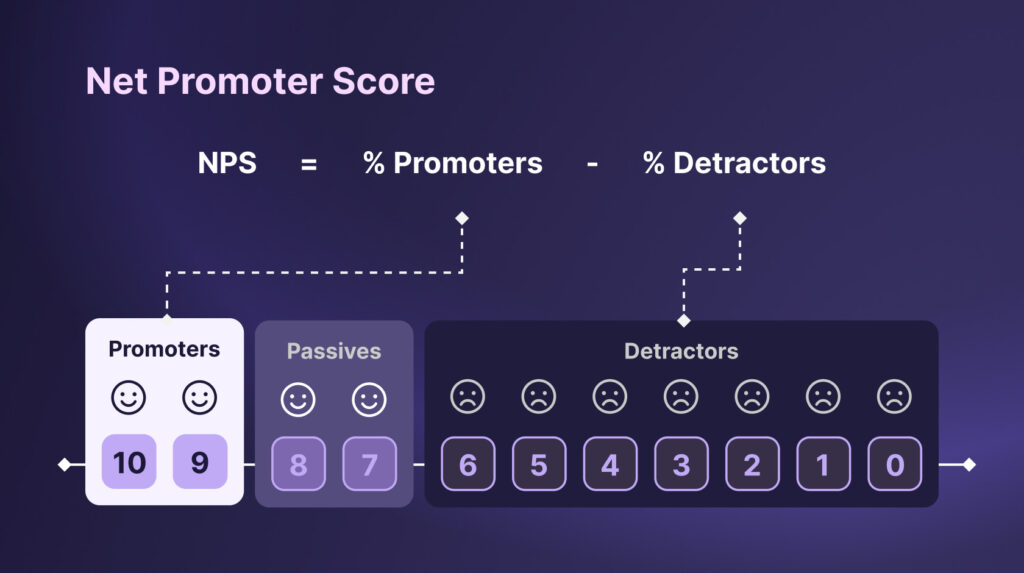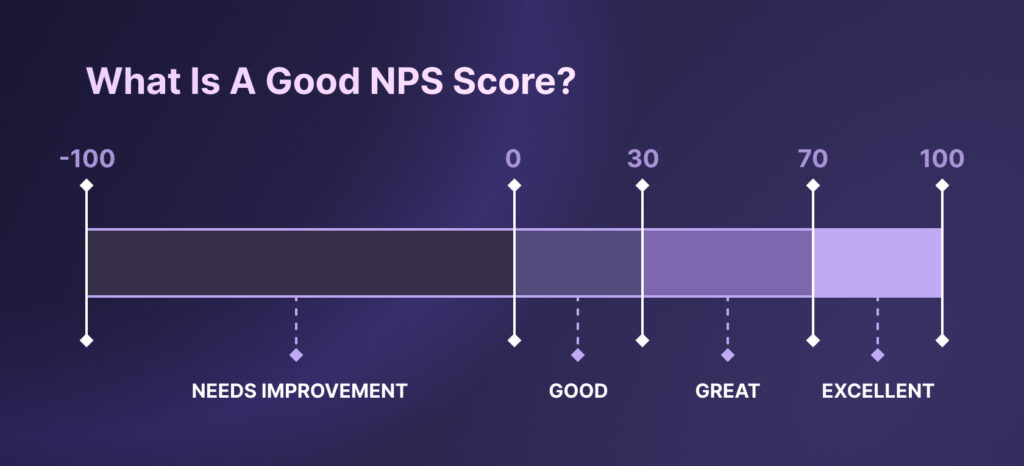
“Your most unhappy customers are your greatest source of learning.” — Bill Gates
Amid rising customer expectations, understanding and improving loyalty have become essential for businesses seeking sustainable growth. One of the most insightful metrics for measuring customer loyalty is with Net Promoter Score (NPS).
A study by Forbes found that 58% of U.S. consumers are willing to spend more with a brand that delivers an enhanced customer experience
By understanding how customers perceive your brand, you can strategically develop your call center agent skills and improve service quality. In this guide, we will cover everything about Net Promoter Score (NPS), with actionable steps on creating effective NPS surveys.
Table of Contents
- Definition of Net Promoter Score (NPS)
- What is the Net Promoter Score (NPS) Analysis?
- What is a Good (NPS) Net Promoter Score?
- How is the NPS Score Calculated?
- Transactional vs. Relational NPS programs
- Key Steps to Implement the NPS Survey System
- What Can You Measure Using NPS?
- What is Employee NPS (eNPS)?
- What Can You Do with Your NPS Score?
- Companies with Highest NPS Scores
- Conclusion
Definition of Net Promoter Score (NPS)
Net Promoter Score (NPS) is a metric used to measure customer loyalty and satisfaction by asking one simple question: “How likely are you to recommend our company to a friend or colleague?”
This straightforward question allows companies to gauge brand loyalty, identify loyal customers, and make strategic improvements based on customer feedback.
The NPS system is widely regarded as one of the most effective ways to track customer loyalty, giving insights that help QA teams focus on refining call center skills, especially active listening and problem-solving skills crucial to customer service.
What is the Net Promoter Score (NPS) Analysis?
NPS analysis categorizes respondents into three main groups. By analyzing these responses, QA auditors can assess the effectiveness of call center agent skills and adjust their training approaches accordingly. Below are the groups:
1. Promoters (score 9-10)
Loyal enthusiasts are likely to recommend your brand.
2. Passives (score 7-8)
Satisfied but unenthusiastic customers, open to competitive offers.
3. Detractors (score 0-6)
Unhappy customers can potentially harm your brand’s reputation through negative word-of-mouth.

What is a Good (NPS) Net Promoter Score?
For call centers, a high Net Promoter Score calculator reflects well on agent skills and customer service quality, implying that the team effectively addresses customer needs and manages calls professionally.

Determining what makes a “good” NPS depends on industry benchmarks and individual business goals. Generally:
- Scores below 0 indicate significant room for improvement.
- Scores above 50 are considered excellent.
- Scores between 0 and 30 are average.
How is the NPS Score Calculated?
The Net Promoter Score calculation is given below:
Subtract the percentage of Detractors from the percentage of Promoters.
Ignore the Passive scores—they don’t affect the calculation.
The formula looks like this:
NPS= Percentage of Promoters−Percentage of Detractors
The resulting score can range from -100 to +100. A positive score shows more Promoters than Detractors.
The resulting score can range from -100 to +100. A positive score shows more Promoters than Detractors.
Transactional vs Relational NPS Programs
Creating an effective NPS survey involves asking the right questions and structuring feedback prompts to collect meaningful insights. For instance:

| Transactional NPS | Relational NPS |
| 1. Measures customer sentiment after specific interactions, such as a recent purchase or call with an agent. | 1. This type is broader, measuring overall brand loyalty. |
| 2. It’s ideal for assessing call center skills and individual performance. | 2. It provides insights into long-term customer satisfaction. |
Incorporating questions about customer service and agent interaction can help identify whether call center skills, like active listening and problem-solving, are meeting customer expectations.
Key Steps to Implement the NPS Survey System
To run a successful NPS program:
1. Define Your Objective
Clarify why you’re measuring NPS. For call centers, this could be enhancing agent skills or improving response times.
2. Customize Your Survey
Tailor your NPS survey to include questions that help gauge specific call center skills.
3. Automate Feedback Collection
Use tools like ConvoZen.AI to automate surveys and feedback analysis.
4. Analyze Results
Look for patterns in Promoter, Passive, and Detractor responses to pinpoint areas of improvement.
5. Act on Feedback
Use insights to train agents on how to improve customer service skills in call centers.
What Can You Measure Using NPS?
NPS is versatile and can help measure several aspects beyond customer loyalty:
1. Customer Satisfaction
How well are customers’ needs being met during interactions?
2. Agent Performance
Measure specific call center agent skills that directly impact customer satisfaction.
3. Process Efficiency
Identify bottlenecks or delays affecting customer experience.
What is Employee NPS (eNPS)?
While NPS is beneficial for customer feedback, employee NPS (eNPS) can also be valuable.
- ENPS measures employee satisfaction, which can impact customer service quality.
- Unhappy employees are less likely to provide stellar service, making it important for call center managers to keep morale high and develop agent skills through training and support.
What Can You Do with Your NPS Score?
An NPS score is more than just a number—it’s an action plan for improvement. Here’s what you can do:
1. Enhance Training
Use insights to develop essential call center skills, focusing on active listening and issue resolution.
2. Reward Promoters
Engage loyal customers with exclusive offers or loyalty programs.
3. Address Detractor Feedback
Investigate why detractors are unhappy and create specific action plans to resolve these issues.
Companies with Highest NPS Scores
Many companies across various sectors, including call centers, are known for high NPS scores. These include:
- Amazon
- Apple
- Netflix
Practical Tips for Creating Impactful NPS Surveys
1. Ask the Right Questions
Start with the classic NPS question, “How likely are you to recommend us to a friend?” but don’t stop there. Follow up with open-ended questions like “What could we improve?” to gather actionable insights.
2. Keep it Short and Focused
Avoid survey fatigue by limiting questions to what’s essential. This encourages more responses and honest feedback.
3. Target the Right Moment
Timing matters—send surveys after meaningful interactions, such as a customer service call or purchase, to capture fresh impressions.
Proven Strategies to Boost Customer Satisfaction and Call Center Performance
1. Invest in Call Center Training
Train agents on crucial call center skills like active listening, empathy, and problem-solving, which directly impact customer satisfaction.
2. Monitor and Act on Feedback Regularly
Use NPS feedback to identify areas for improvement in service and processes. Create a feedback loop so that agents are aware of how they can enhance their performance.
3. Implement Real-Time Support Tools
Consider tools that provide agents with instant access to customer information and AI-powered suggestions during calls to improve response accuracy and speed.
Conclusion
Achieving a high NPS score is a journey of consistent improvement and a customer-centric strategy. For QA auditors and managers, addressing areas like call center job description skills and customer feedback management is crucial to customer loyalty.
However, manually analyzing feedback and developing agent skills can be challenging. That’s where ConvoZen.AI comes in—this SAAS tool provides end-to-end solutions to analyze NPS feedback, automate training based on feedback insights, and measure agent performance with precision. The capabilities allow you to boost call center skills across the board, turning insights into results.
Ready to start measuring Net Promoter Score®? Book a demo and transform your call center with data-driven insights and actionable feedback solutions!
FAQs
NPS, or Net Promoter Score, is a metric that measures customer loyalty by asking how likely customers are to recommend a business to others, using a scale from 0 to 10.
To calculate NPS, subtract the percentage of Detractors (0-6 ratings) from the percentage of Promoters (9-10 ratings). Passives (7-8 ratings) are ignored in the calculation.
You can run NPS surveys by sending the primary NPS questions via email, SMS, or on-site pop-ups, followed by open-ended questions to gather additional feedback.
An NPS survey includes the main question, “How likely are you to recommend our company to a friend or colleague?” with a 0-10 rating scale, plus optional follow-up questions for more insights.
Use your NPS score to identify customer satisfaction trends, address pain points, improve products or services, and enhance customer experience to drive loyalty and growth.


